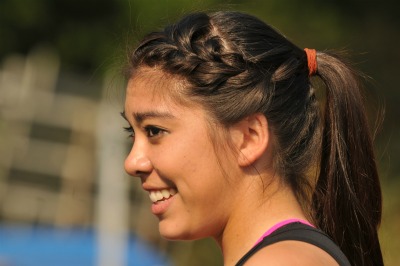
The Seminole Athletic Conference
Track and Field Championships
By Ralph Epifanio
Trackside, 776 B.C.
What we now know of as track (and field) was probably invented by the Greeks a long, long time ago. At first, it was a simple affair, with basically only one event; the 200. Since track began as an amateur sport, this distance was no doubt determined by the simple concept that then, as now, 200 steps (meters) is about as far as you can race, all-out, without actually training.
The earliest known track was located at ancient Olympia, in Greece. It was not an oval, but a rectangle. Archeologists have determined that it was 212.54 meters long and 28.5 meters wide. At one end was the finish line, at the other a series of posts through which a rope-and-gate contraption prevented “false starts.” Of course, today we place greater trust in an athlete’s integrity…but standing by--just in case--is a guy with a gun.
In that very first race was a cook remembered longer for his running ability than his culinary expertise—or perhaps because of the latter—who won the race of his life. Although Koroibos (perhaps originally spelled Coroebus) is linked to the origin of the Olympics, to the ancient Greeks it was no doubt mighty Zeus himself who inspired its continuation, and it was held every four years for the next 12 centuries. (The temple dedicated to this deity, complete with a 43 meter tall gold and ivory monument to his omniscience, once faced this hallowed ground.)
In time, other events were added to the competition, such as the javelin (man’s version being far less electrifying than that of Zeus), discus, jumping (or leaping), and boxing/wrestling. When combined with a footrace, these five events comprise the ancient pentathlon. Eventually, the addition of two-and four-horse chariot races, which raced distances of from two to eight miles, were accommodated in a second, longish-oval facility, called a hippodrome.
As previously mentioned, the 200 (called stadia, which is where we get the word stadium) was the first distance that was run. After awhile, because some are born slow starters, the diaulos (2X the stadium) was introduced. It required athletes to make a 180 degree turn around a pole at the far end of the running course (suggesting the term “pole position”), and thus creating the 400. For the slower, skinnier guys, they added the dolichos, or long distance race; 1400-4800 meters. (If these distances remind you of the 1500 and 5000, it may not be a coincidence.)
At that point, really long races were reserved for the professional messengers, such as the Athenian Philippides (one version of numerous spellings). You might know him as the herald who ran 40 kilometers from Marathon to Athens, and after announcing the Greek victory over the Persians, dropped dead? Well, that is only part of the story. Apparently, he had previously run 246 kilometers (in less than 48 hours) from Athens to Sparta, reporting landfall of the Persian fleet, and asking the latter city-state’s military citizens for help. (The Athenians were the runners, the Spartans the fighters.)
Of course, now that the big guys were in town, they too wanted to compete in “the games,” so the hoplitodromas was added to the Olympics. This event was run in armor, which was basically a helmet, shin guards, and shield…but nothing else. Did I mention that the Greeks ran au natural?
Since guys were--even then--guys, wives weren’t allowed to watch the Olympics. It is an historical footnote that one woman, Callipateira, disguised as her son’s (male) coach, snuck in to witness her son Peisirodos’ victory in the boxing competition. However, in celebration of his success, her rather non-masculine response—or perhaps it was her soprano voice—“exposed” her gender. Since they didn’t toss her off the cliffs of Mt. Typaion (the penalty in those days for non-males being caught in “reserved” seating), she must have had a rather convincing alibi.
However, women were women then too, and after the passage of “Title XVI”, Greek women created the Heraea (or Heraean) Games, a separate but equal—well, 5/6 equal in distance, lest they show up the men—competition. Of course, the guys made all the rules, so they were allowed to watch. (Why is it that guys always get their way?) Plus the women had to be unmarried (read: virgins), mostly clothed, and competed in three age categories (children, adolescents, and young women).
Track has come a long way in (nearly) 3,000 years. We’ve added curves, clothes, and a bunch more events. And there’s more to come. In this meet, we had an approximation of a new two-man event—the run-wrestle-hop-skip-and jump--when an inattentive runner tried to cross the TJ runway while a triple jumper was in full stride. (In this case, neither athlete was credited with a “takedown”.) Additional demonstration events—as shown in the photo montage--include:
· The “pizza hut relay”; four athletes, each with their own leg, sprint across the track while eating a slice of pizza.
· The 100 meter “pole-sprint”; as many athletes as can fit in the end zone sprint 100 meters and vault the goal in the opposite end zone. First one to land (alive) wins.
· The modern chariot steeple (for coaches only); two men in a golf cart weave their way completely around the infield, swerving through the crowd, pass under the water hazard, and finally enter the green shed at the start/finish line. As the first one goes through, the doors close automatically, “sealing” the victory.
· The two-man baseball throw (inspired by the wooden fences on the first turn). One guy-the thrower—hurls a ball as far as he can, trying to clear the fence. The other—the catcher—retrieves the balls that don’t quite make it over. After three throws, the one with the most home runs wins the derby.
· The water guy added an eleventh hurdle—a water cart—to the outside lane. (He thought he had time to “top off his tank.”) No doubt this water “hazard” will eventually become a final “hurdle” for those who have found their event too easy.

These latter suggestions, of course, are made purely in jest…although the photos show that they did, indeed, occur. Once this meet began in earnest, however, there was little room for frivolity…well, maybe just a little room, depending upon who was looking through the camera lens.
Day 1
Don’t worry, there were only two. On Wednesday, April 11th, meet organizers held the field events (preliminaries and finals), and the sprint preliminaries. When things started moving too smoothly, it was decided to wait until the field events concluded before starting the running events. This still allowed enough time for everything to finish by about 9:00 PM—including my camera’s ability to take decent photos--except the Boys’ pole vault, which may still be going on. Actually, take that back. The results sheet shows that Chris Tiedge, of Hagerty, in a final successful attempt, hurled himself into the darkness, and cleared 11’6”.
 The shot and discus competition were staged in the “outback,” so-called because of their proximity to a branch of that well-know restaurant chain of the same name, and the suggestive aroma of broiled steak and “Bloomin’ Onions,” which wafted across the landing area. With those fried onions barely beyond Nathan Milch’s winning 161’6” discuss throw, athletes and sportswriters alike could almost taste those 3000 calories and 134 grams of fat whenever the wind blew the right way. Who could think of a better snack just before (or after) competition in the weight events…or perhaps while conducting interviews?
The shot and discus competition were staged in the “outback,” so-called because of their proximity to a branch of that well-know restaurant chain of the same name, and the suggestive aroma of broiled steak and “Bloomin’ Onions,” which wafted across the landing area. With those fried onions barely beyond Nathan Milch’s winning 161’6” discuss throw, athletes and sportswriters alike could almost taste those 3000 calories and 134 grams of fat whenever the wind blew the right way. Who could think of a better snack just before (or after) competition in the weight events…or perhaps while conducting interviews?
When asked if practicing so close to the restaurant’s kitchen was an inspiration, or a distraction, Milch—all business—was silent. I wondered if the thought ever occurred to him that they might be a willing sponsor. (He did seem to be in a big hurry to leave that day. Dinner plans, perhaps?)
Nathan, though only a junior, is currently near the top of both the shot (10th) and discus (12th) lists in the state of Florida. What’s amazing is that he’s only just getting started.
“My friend’s brother, David Levin, threw here,” Nathan told me. “I was a freshman when he was a senior. In his first year”—his only year in the weight events—“he made it to States (eighth with a 150’ throw at the May 8, 2010 FHSAA finals). I heard about what he did—I’m close friends with his little brother, Michael--and kinda wanted to try it after that. He’s a big kid. Now he throws for UF.”
In college, Levin moved over to the weight throw (55’ ¼”) and the hammer (169’5”). Meanwhile, Milch had a double win in this conference meet--Nathan tossed the ball 50’ 2”—adding his sixth SAC title (two Freshman/Sophomore, and four open titles) in less than two years. One might wonder whether, in the midst of all his success, there are times when one event plays favorite to the other.
“They both kind of advanced the same amount until this year. I got a big PR in the shot. I threw a 51’6” at the Bob Hayes Relays (March 17, 2012).
“In the discus, I threw a 154 at the beginning of the year (1st at the Lake Brantley Open on February 25th), and couldn’t get back at it, but then threw a 158 in a practice meet. Then I threw a 162’1” at the Florida Relays last week (April 7th).”
Despite having thrown these former Greek weapons for less than two years, Milch is already a convert.
“I play football—outside line backer—and basketball—shooting guard—because I like to. It’s fun. But I couldn’t see myself playing in college. I view myself as a track athlete, now more than ever.
“I consider the discus as my main event. The shot is secondary. (In the shot) I’ll get two or three good throws, after punching six or seven, and I’m done for the practice. But with the discus, I practice much longer. I really enjoy it. It’s that feeling after you get a great throw…and I’m usually pretty consistent. My goal for this year is to get a 170.”
Nathan is quick to point out that he has not gotten where he is without help.
“Definitely, there’s Coach Carpenter. He helps me with the mental aspect; to be mentally prepared.”
And of course, there is his inspiration for attempting the event(s) in the first place, David Levin.
“Last year, before the Districts, David Levin came to practice and gave me some pointers. He was a secondary thrower at UF, and came to two or three practices when there was only myself and Coach Carpenter.”
With his current rankings, and still having the best part of two years to improve, Nathan’s meteoric rise to prominence might be a premonition of even greater accomplishments to come.
That might also come to pass in the case of the Girls’ double winner, Rebecca Evans. She, too, is only a junior. Currently, her best discus throw is 129’ (May 28, 2011 at the Golden South Invitational). In this meet she hit 126’ 3” in the discus (currently 14th best in Florida), and 35’ 6-1/2” in the shot put, winning both.
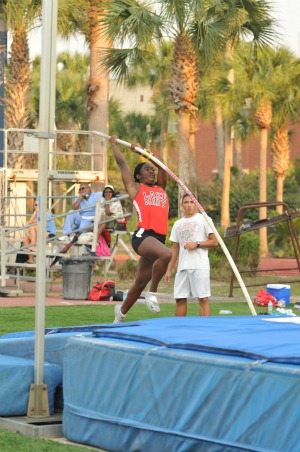 Citius, Altius, Fortius (Faster, Higher, Stronger)
Citius, Altius, Fortius (Faster, Higher, Stronger)
While I was missing the shot and discus—I actually had my discus-sion with Nathan before Day 2’s events—the rest of the field events were going on in the bright sunshine of Tom Storey Field. With the competition being—while we’re in to ancient languages—ferus (fierce), there were no more double winners. However, worth noting, among the winners’ notable performances were Erica Sergeant’s 12’ 1-1/2” conference record in the pole vault; freshman Mikaela Martin’s two PRs (a winning 17’7” in the long jump, and second at 4’10” in the high jump), and freshman Raheen Powell’s win in the triple jump (42’5”).
Lake Mary sophomore Erica Sergeant came into the meet with a 12’ 7” personal best (set at the March 16th, 2012 Deltona Invitational), and a 13 meet winning streak. The last time she didn’t come out on top was at the May 28, 2011, Golden South Invitational, way back when she was a freshman. (In that meet, senior Lindsey Enders jumped 12’6”, and Sergeant’s 12’ was second.) So it comes as no surprise that, in this meet, after setting the conference pole vault record and winning her fourth SAC title (two Freshman/Sophomore and two open), she would go on. But 12’8”?
“We’ve got the meet record, now we’re going for a personal record; 12’8,” explained her pole vault coach, Bill Cashman.
“I was trying to get a personal record coming in,” Sergeant added. “I didn’t even know what the (conference) meet record was. But after I got here, I realized what it was. After I got that, I was trying for a PR. I’m happy that I’ve got a MR, but I would have rather gotten a PR.”
All three of her jumps at that final height were unsuccessful, but you can’t help but think that her setback is only temporary.
“I was close to making it. My top phase—getting over the bar—was the problem. I was either in front of it, or landing on top of it…or it was not staying close enough to the pole. I was shooting straight out, instead of straight up.
“(Pole vaulting) takes practice. It’s like a never ending journey to discover your true potential.”
That statement could certainly be expanded to the aforementioned freshmen, Sanford Seminole’s Raheem Powell and Lake Mary’s Mikaela Martin.
Powell dominated the previous SAC Freshman/Sophomore Meet, winning the 110 hurdles (a 16.07 PR), the 300 hurdles (a 42.02 PR), the long jump (a 21’4” PR), and the triple jump (43’2”). However, with three and a half years to go, his journey is just beginning. This time, against the best in all grades, he was one for four. The sole victory, however, came in what is arguably his most technical event, the triple jump. And yet, this is his first year in that event.
“My coach (Ken Brauman) asked me to try it,” he explained. “I couldn’t get it at first, but he said, ‘Keep trying.’ That was at the beginning of the track season.”
And what does a 21st century athlete do when faced with such a dilemma?
“I started watching You Tube, and saw how they were doing it. I tried to do it like them. Then I came out to the Seminole track and tried it.”
 At that point, Brauman began putting some finishing touches on Raheem’s You-jumps.
At that point, Brauman began putting some finishing touches on Raheem’s You-jumps.
“My coach told me that I needed to ‘reach further’ on my second step. That helped me a lot. I was jumping about 37’. The longest this year was 45 (at the March 28, 2012 Seminole High School Developmental Meet #2), and that took a month.”
“He would run ten events if he could,” Brauman added. “He has fun doing it. He likes to stay busy.”
So I asked the obvious.
“What about the decathlon?”
“What’s that?” he asked innocently.
“That’s where you do ten events over two days.”
He smiled broadly.
“Yeah, I’d like that!” he said.
If Powell has a kindred spirit, it might be Lake Mary’s Mikaela Martin, who just turned 15.
“You just have to stay focused,” she says of regularly being involved in four events. “You have to keep everybody and everything else out (of your mind). The long jump and triple jump are my favorites. I was a gymnast before, so they come naturally.”
“A gymnast?” I asked.
“My Dad went to the Olympic trials in gymnastics (all around), and my mother was a gymnast and a coach, so I was in the gym from when I was five weeks old. I started competing when I was…wait, can I ask my parents?”
(A short trip to the temporary family enclave, hidden deep inside Brantley Woods.)
“She started competing when she was three years old—in all around competition—at the Tropicana Dome in Tampa,” remembered her mother, Beth. “She competed until she was 11, then she branched out, experimented a little, and found track.”
Mikaela picked up the conversation.
“I started the 100 hurdles the summer after sixth grade,” she said, “with Coach Wise (on the AAU Central Florida Gliders). I started three stepping right away, probably because of gymnastics.”
Between the two hurdle events, Mikaela has no clear favorite.
“I like both.”
And being a former distance runner, I asked the budding “expert” the difference in strategy between the two.
“In the 100, you want to get your feet on the track. In the 300, you have to keep down the number of seconds between the hurdles.”
Although Mikaela won both hurdle events at the SAC F/S meet (15.42 in the 100 and 46.74 in the 300), plus the long jump (17’4”), the “older competition” trimmed that down to first in the long jump (a 17’7” personal best) and the 100 hurdles (15.92), and second in the 300 hurdles (47.05) and high jump (4’10”).
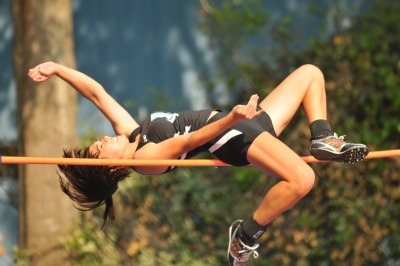 Winning that high jump was Mackenzie Geigher of Hagerty. Geiger’s “pre-jump stretch” is as entertaining as her high jump…well, maybe more so. But she doesn’t just jump “up”. After winning that event (in 5’0”, a PR), she went over to the long jump, where she traded places with Martin (Geiger was second with a 15’6” distance), then on to the triple jump (finishing fourth with 33’ 11-1/4”, a tad off her 34’ 4-1/2” best (at the March 10, 2012 Spruce Creek Invitational).
Winning that high jump was Mackenzie Geigher of Hagerty. Geiger’s “pre-jump stretch” is as entertaining as her high jump…well, maybe more so. But she doesn’t just jump “up”. After winning that event (in 5’0”, a PR), she went over to the long jump, where she traded places with Martin (Geiger was second with a 15’6” distance), then on to the triple jump (finishing fourth with 33’ 11-1/4”, a tad off her 34’ 4-1/2” best (at the March 10, 2012 Spruce Creek Invitational).
Taylor Long (Lake Brantley) won the triple jump with a 34’ 1-1/4” effort, her second SAC TJ title (34’ 2-3/4” won on April 13, 2011).
“I think my triple jump is the strongest,” she told me, “but I try my hardest in all of the events. I just take one at a time.”
But how does such a busy athlete sort them out?
“I finished the long jump before I started the high jump, because I came in at 4’8”. I do that to conserve my energy. It’s also a mental thing; not seeing the bar really low. In comparison, when the bar goes up to being really high, it could psych you out. I try to prepare myself mentally for the higher heights.”
When asked about colleges, the UF-bound senior was even ready with her major.
“I’ve always liked the school, and they have good academics. I want to be a pediatric orthopedic surgeon.”
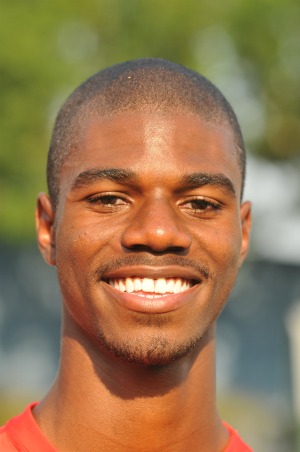 Another senior jumper with definite plans for his future is Lake Brantley’s Donavon Franks.
Another senior jumper with definite plans for his future is Lake Brantley’s Donavon Franks.
“I plan on attending Robert Morris University, in Pennsylvania, and majoring in accounting.”
Makes sense, since his track numbers are already excellent: in this meet, he was first in the long jump (21’6”), second in the triple jump (41’ 5-1/4”), first in the 200 (22.78), and anchor in Lake Brantley’s first place 4 X 4 (3:21.57).
“I like the 4 X 4 the best,” he explained. “It’s a team race, and I’m not just running for myself. I push myself for the other guys.”
Coming in to the meet with bests of 22’ 2” in the long jump (March 30th at the Holy Trinity Elite Classic), and 44’ ½” in the triple jump (the 4A District 2 meet last April 30th), his jumps in this meet might seem uninspired; however, there was good reason.
“My coach said, ‘If you get the lead, just pass on the others (tries),’” Donovan explained. “He said, ‘Warm up really good, get enough of a jump for a good one, and save your legs for the 200. I got the first in, and passed two jumps in the finals.”
Despite that heavy load, that 200 was a solid personal best, but his 400 might have been the best effort of the day, as his anchor figured prominently in Lake Brantley’s 12 second margin of victory.
Clinton Christ, by contrast, had a “short” day.
“I’ve done the 400 (58.34 personal best on March 28, 2012), 4 X 1, and long jump (19’3” at the February 9, 2012 Lake Brantley Developmental Meet), but in this meet, just the high jump,” he said.
Clinton came in with a personal best of 6’6”, at the March 25, 2011 Deltona Invitational, but won here with 6’4”.
“I’ve definitely jumped against all of them before. I was fairly confident that I’d place in the top 4. My main competition was Farrin (Browning) from Seminole. We had a developmental meet on his track last week. They have a cinder track, and I made the mistake of wearing the wrong shoes. I thought I was sliding around the whole meet. I was more worried about not getting hurt, than giving 100%. I believe he got 6’2”, and I jumped, I believe 6’0”. It wasn’t a good day, and I tried to put it out of my mind.”
Lake Brantley’s track created a different challenge for Christ.
“The high jump pit is tucked into a corner, and is on an angle. But I’ve gotten used to it because I’ve been coming here for three years. However, it’s not my idea of an ideal track.”
But his best proved to be an ideal height for winning.
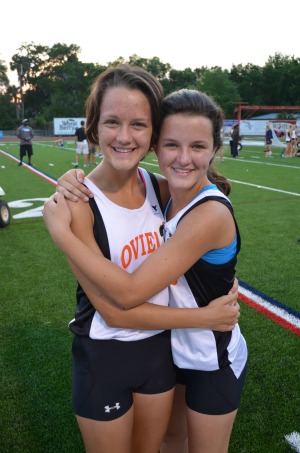 Day 2
Day 2
With field events behind them, a night’s rest, and a late start (6:30 PM or so), the competition was lined up for a good night. On the other hand, with no preliminaries, the races were packed in pretty tightly, and those competitors who were running doubles—especially in the distance races—would have less time to recover between races.
Considering who was running, however, it hardly mattered. First, there was Lake Brantley’s Otneil Teixeira, quite possibly the best 800 meter runner in the state. After winning that in 1:55.40—and jogging almost nonstop around the track—he won the 1600 in 4:16.99.
Likewise, Hagerty’s Amy Ankli won her two—not to mention being part of the 4 X 8—the 1600 and the 3200 (5:16.69 and 11:30.93, respectively). Winning all by a bunch, I asked if it gave her time to think ahead.
“I tried to focus just on this race(s), not look forward to the Districts. Next week will be really tough. I’m nervous, but I’m also excited. I just want my team to do well. Our goal is always to do the best we can do; anything we can to motivate each other.”
Like wearing identically colored blue hair ribbons?
“Our 4 X 8 began wearing them at last week’s meet. It is a way of unifying ourselves.”
Which leads us to “The Turk Triangle.”
Danielle Turk, a junior at Oviedo, had two things to celebrate after her victory in the Girls’ 800. First was her conference championship, then the fact that she might just be one week closer to having three Turks on the Lions' pride. During the meet she introduced me to her sister, Marissa (2:44.49 in the 800)—“it was her first official meet in the 800,” she said—then mentioned younger-still Logan.
“My brother, Logan, will be a freshman next year, but he plays lacrosse. If he joins track, we can be the ‘Turk Triangle,’” she said, forming one with the fingers of two hands.
A bold gesture of cohesiveness for one who so actively pursues the “loneliness of a long-distance runner.”
“I just like being that it’s just me out there,” she said. “I don’t depend upon the team. Whatever I do, it counts in the results. Even in a big meet, I go into it as a meet, and just a meet. Whatever will happen, happens.
“The most important thing for me is just commanding the race. I push myself as hard as anyone I know. I know what I’m capable of, and want to hit that every time.”
For now, that is being a two-time conference 800 meter champion (2:18. 83 in 2011 and 2:19.03 in 2012), with a personal best about a second faster (2:18.19 at the May 6, 2011 3A FHSAA State Finals).
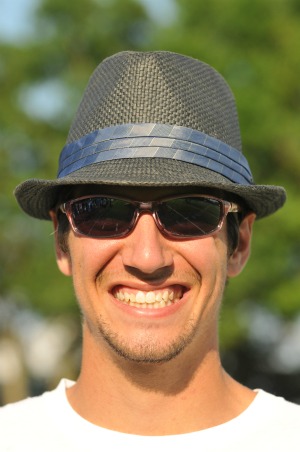 Sneaking up on the Competition
Sneaking up on the Competition
Unlike the aforementioned trio—Teixeira, Ankley, and Turk, who relish their roles as front runners—Hagerty’s Peter Licari runs a different kind of distance race. He uses a “wait and pounce” strategy. In fact, he has gone so far as to don a “disguise” in order to keep his competition guessing.
“Where’s Peter? Has anyone seen Licari?”
Right behind you, me bucko.
“I had just run the mile, and that was a season’s best (2nd in 4:26.90),” Peter explained after the 3200, “so I was a little tired. I figured I’d have to run a smart race, instead of a fast one.”
In that 3200 race were a number of talented runners, most of whom lacked experience against Licari’s well-honed tactics. First of all there was Hunter Morgan, who, although a senior, is in his first year of track. He came in with a 10:06.92 PR (Holy Trinity Elite Classic on March 30th), but here at SAC had just finished the 1600 in 4:31.88, a new PR. Next was Hagerty’s Hunter Menning, with an almost identical PR to Hunter #1, 10:06.17, which he posted at the Royal Invite on the same day as Morgan. Cameron McCutcheon, the SAC Freshman/Sophomore Champion (10:33.26), ran a 10:16.85 best at this year’s (March 22nd) FSU Relays. And lastly, Adam Pfeifle of Oviedo had lost to Licari the week before when both he (10:18.80) and Licari (9:47.52) set PRs at the Saints Invitational, a race that Blues Brother #3 won.
“I knew that they would not recognize a ‘sit and wait’ tactic, because that would only happen in a big meet. Hunter (Morgan) ran the 4 X 8, and nearly caught me in the 1600. I knew he had leg speed. Cameron has been expressing a ‘sit and kick’ strategy on Facebook, or that’s what I’ve heard. I don’t go on it much; too much drama.”
Instead, Licari created his own real-life version. Taking charge of the pace, then outkicking all of them in times far short of each runner’s potential, Licari won his first SAC Championship.
“1st in the 3200…2nd in the 1600…best conference showing ever. On my last one, too,” said the senior.
And next?
“I go into the Districts with a little bit of confidence, but I know the competition is going to be tough. I have to use the base I’ve built up, and need to be ready to do whatever it takes to be number one.”
Last year he did just about the same thing, winning both the 1600 (4:28.86) and the 3200 (9:58.47) against runners who came in with faster PRs. This year those races will not be for the faint-hearted.
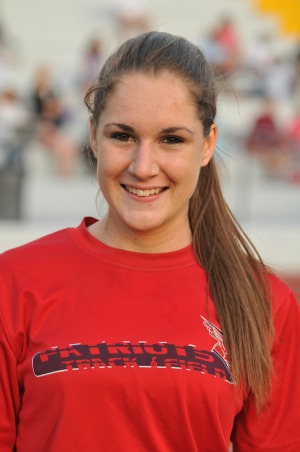 Just Plain Citius
Just Plain Citius
Only one athlete—DaKesha Jackson, Seminole—won two sprints; the 100 in 12.27 and the 200 in 25.53.
The diaulo… I mean 400… was, like the others, a “lone win” for seniors Elana Ainsley and Kenny Lane, both of Lake Brantley.
“It’s (partly) a mental race,” Elana explained to me. My coach teaches us how to run according to our strengths.”
“In practice, we do sets of two 600s, every Monday and Tuesday,” added Kenny. “That, and the 800 (2:03.30)—which I ran at the beginning of the season—helped me to prepare for the 400.”
“Coach Bennett has been teaching me how to run since my sophomore year,” continued Ainsley. “He’s with me at practice every day, and he’s an amazing coach. Right now we’ve been working at going under 60. Today, I ran 60.01, so it’s definitely ‘do-able.’”
Just ask her male counterpart. Kennth—I guess that’s how it’s spelled—who won his heat in the semis in a school record (and PR) time of 49.03, then bettered that performance in the finals with a winning 48.81. About the only thing as impressive was a feat that didn’t show up in the meet records.
Winter Springs’ 110 hurdler, senior Kwame Knight, tripped on the ninth hurdle and went (almost, but not quite) down. With a PR five seconds slower than the eventual winner, he could have just stayed down and called it a day, but he showed the gutsiest (and most graceful) recovery I’ve ever seen. Catching himself, he stood, then in the next step easily cleared the last hurdle, beat his closest opponent, and set a new PR (20.01). It’s too bad he’s a senior. It would be great to see more of his bravado.
 Two athletes whose challenges may not have been as readily apparent were Antonio Johnson and Alyssa Younker. Antonio (Lake Mary), who won a rare 100-200-400 triple at the Freshman/Sophomore meet, had a lone “1” in this one (11.14 in the 100). Alyssa (Hagerty) won the 300 hurdles in 45.33, but with only one event’s rest before her next race, still managed to take second in the 200 (26.18).
Two athletes whose challenges may not have been as readily apparent were Antonio Johnson and Alyssa Younker. Antonio (Lake Mary), who won a rare 100-200-400 triple at the Freshman/Sophomore meet, had a lone “1” in this one (11.14 in the 100). Alyssa (Hagerty) won the 300 hurdles in 45.33, but with only one event’s rest before her next race, still managed to take second in the 200 (26.18).
Lake Brantley hurdler Donovan Franks, on the other hand, seems to have sidestepped his challenges. While he runs both hurdles, his 110s are definitely his strongest. In 2011, he took a SAC second place (15.75) into the 4A District 2 Meet and won (14.67). This year, he takes a first (15.18) and hopes to repeat.
In the 110/300, one of his most erstwhile competitors is teammate Dillon Morton, with whom he seems to “trade success,”…or do they?
Dillon: “No.”
Donovan: (Laughs) “We work hard to beat each other in practice.”
Dillon: “Competition.”
Donovan: “But I also had the 100.” (He was fourth in 11.57.)
Dillon: “I have stamina. I keep the pace (in the 300). When I come out of the curve, I pass everyone and kick.”
Donovan: “I just try to keep up. Today, the 100 and 110 hurdles were back to back, so I was tired.”
Another Lake Brantley Donavon (different spelling), Frater, is like-minded to Dillon in his strengths.
“I don’t have a quick start off the blocks, but I have long legs--and the endurance--so I run the 200 and the 400.”
In this meet, Frater—as already mentioned—won the long jump, later added the 200 (22.78), and finished with a team win in the 4 X 4, running anchor.
“I’m an all-around athlete. I don’t just do running events, but also field events, to help my team.”
Which brings us to those results. (I’ll bet you thought we’d never get there!)

Team Results
Both the Lake Brantley Boys (210 points), and the Hagerty Girls (213 points) had nearly double their closest competitor’s score. (The Sanford Boys had 106, and the Lake Mary Girls 140.) Both winners not only scored in every event, but averaged more than 12 points per event, and that included relays. There is simply no way to stop such a display of depth…except perhaps a well-placed water tank.





